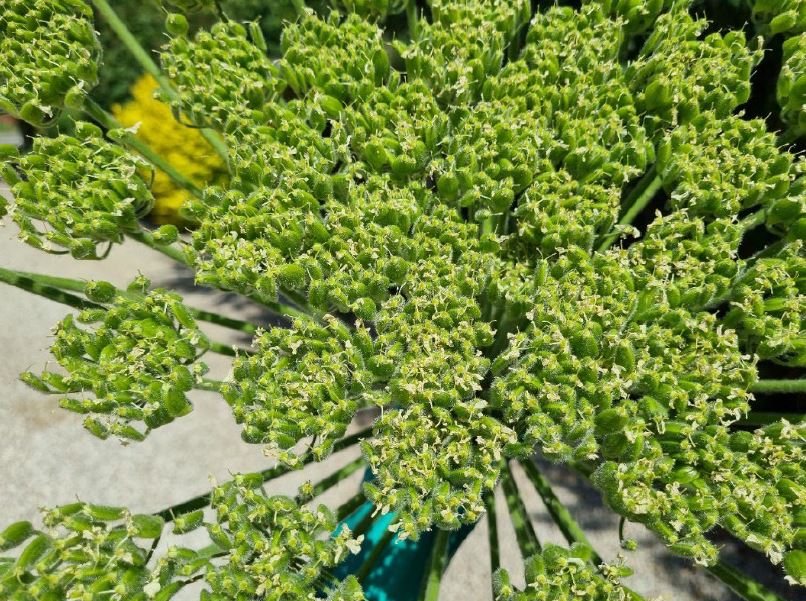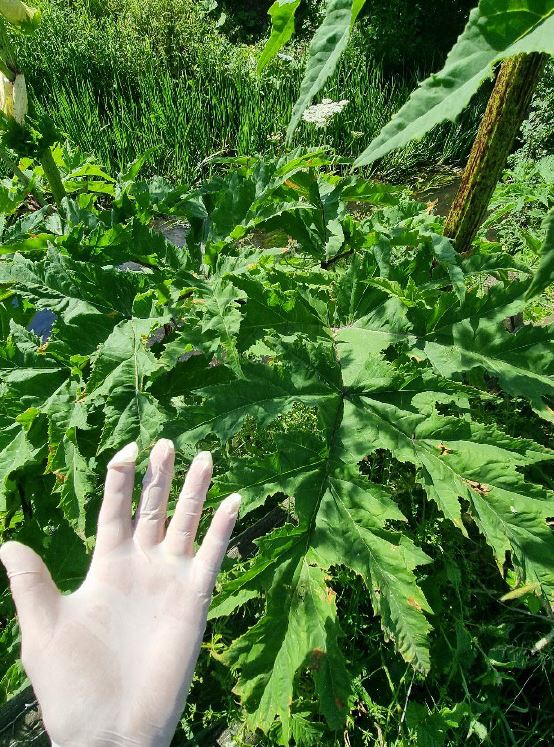What Makes Giant Hogweed Poisonous?
Giant Hogweed , unlike Japanese Knotweed poses a serious threat to human health and can put people into hospital. Giant Hogweed contains a photosensitive sap which, on contact with skin, reacts with UV light and can produce severe blistering. This can be so severe sometimes that it results in hospitalisation. More than that, once exposed to this sap you can find that your skin continues to blister, when exposed to sunlight, for some years following the initial event.
Severe health risk

Control programme
– Giant Hogweed ( Heracleum mantegazzianum)
Site
– Residential property in the Midlands

Background
A private individual contacted Conservation Land Services concerned that he had a stand of seven Giant Hogweed plants in his riverside meadow and urgently required a control programme.
The Giant Hogweed was already in flower and he needed a fast response to, not only instigate a control programme, but to protect himself and his family and also ensure that the flower heads were removed to prevent the Giant Hogweed plants going to seed.
What’s the problem?
Non-native invasive weed on Schedule 9 of the Wildlife and Countryside Act (1981)
Giant Hogweed is listed on Schedule 9 of the Wildlife and Countryside Act (1981), the same as Japanese Knotweed (Reynoutria japonica) and so is one of the listed non-native invasive species, which requires you as a landowner to prevent the Giant Hogweed from spreading beyond your boundaries into neighbouring land.
Giant Hogweed Seeds
Rapid infestation through huge seed production

Giant Hogweed ,again unlike Japanese Knotweed, produces viable seed and a mature Giant Hogweed plant can produce twenty to fifty thousand seeds, which can remain viable for two years. It is vital, when considering control options, to prevent the flower from flowering and or producing seed.
What Was Done?
Conservation Land Services Ltd identified and recorded all the Giant Hogweed plants, removed the flower heads for bagging and removal offsite for incineration. Excavation is an option with Giant Hogweed, but as it was not a realistic option in this case, a herbicide control programme was put in place.
Conservation Land Services Ltd will be monitoring this site for at least two years, as the Giant Hogweed seeds can remain dormant for two years.
Precautions to take with Giant Hogweed (Heracleum mantegazzianum)
- Do not touch it with bare skin
- Immediately fence off the area and put appropriate signage in place
- Inform the site manager and ensure the first aid officer is aware of the issues
- Put a site notice up bringing to attention the presence of the Giant Hogweed and the dangers it represents to human health
- Get a control programme in place immediately.
Key identification features with Giant Hogweed ( Heracleum mantegazzianum)

Everything about Giant Hogweed is Giant.
- It can be 3 to 5 m tall
- It has a huge flower head (referred to as an umbel) of white flowers 80cm across
- The stem can be 10cm in diameter and is hairy, sometimes with purple patches
- The leaves can be over 1m long

Control options with Giant Hogweed
Key is to break the life cycle by preventing seed production.
Excavation
Giant Hogweed has a simple tap root and the seed bank tends to be shallow
Herbicide
Giant Hogweed is susceptible to herbicide control programmes.
Other plants that can be confused with Giant Hogweed
Common Hogweed (Heracleum sphondylium) everything is much smaller
Cow Parsley (Anthriscus sylvestris) stem is very rarely more than 150cm tall and the leaves are feathery.
Site Check for Invasive Weeds
Contact us to discuss arranging a site visit report to check your site for Japanese Knotweed and other invasive weeds likely to give rise to problems on your development site.
Book an appointment for a quick call









